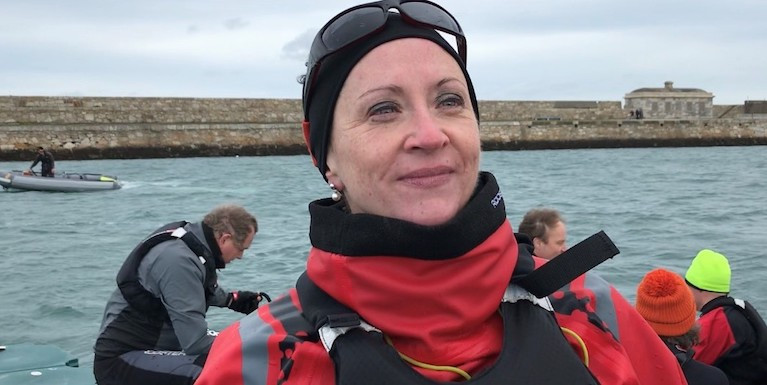Displaying items by tag: Irish National Sailing Club
Irish National Sailing Club Elect Patricia Kelly as Commodore
The Irish National Sailing Club is pleased to announce the election of Dun Laoghaire Laser sailor and dinghy instructor Patricia Kelly to the position of the first Commodore of the six-year-old club at their AGM held online on Monday the 21st of December 2020.
Patricia is a relatively recent convert to sailing, having taken a beginner course roughly five years ago onboard a keelboat before trying out dinghy sailing after joining the Irish National Sailing Club. Patricia embodies the ethos of the INSC, which promotes pay as you go sailing in a fun and safe way and becoming totally immersed in all things small boat sailing.
 Patricia Kelly (right) with (right to left) fellow INSC dinghy instructors Alex Wan, James Linton, Nick Smith and Joan Sheffield
Patricia Kelly (right) with (right to left) fellow INSC dinghy instructors Alex Wan, James Linton, Nick Smith and Joan Sheffield
After a short while using the INSC Laser fleet, Patricia took the plunge and bought her own Laser, and was immediately an enthusiastic sailor and progressed quickly. She was instrumental in organising a small group of INSC members to get out on the water for a series of mid-week lessons with various coaches from Dun Laoghaire. This flare for making things happen was a natural asset when the club teamed up with the Irish National Sailing & Powerboat School to develop a group of adult dinghy and keelboat instructors in 2019.
Patricia flew through the various assessment and training modules qualifying as a dinghy instructor and was straight out onto the water that Summer introducing many new sailors to the sport, and most importantly encouraging them as they took their first steps after their courses while sailing with the club.
 Patricia Kelly trials the INSC’s new RS Zest dinghy, before designing a training programme for new club members on these new craft
Patricia Kelly trials the INSC’s new RS Zest dinghy, before designing a training programme for new club members on these new craft
Elected onto the INSC committee, Patricia was instrumental in driving numerous projects to help the Club develop a pathway and strategy to get more people afloat, and was a contributor to all club activities including putting in a number of shifts at the RS Super Series in the depths of Winter.
Patricia is regularly found on race courses, both in safety boat duties such as the 2019 Laser Masters and is also a regular competitor in her Laser in DBSC Summer and DMYC Frostbite series.
 Patricia Kelly (helm) providing safety cover at a RS Super Series Event in Dun Laoghaire
Patricia Kelly (helm) providing safety cover at a RS Super Series Event in Dun Laoghaire
A contribution of particular note was the heading of a subcommittee tasked with developing a training programme for INSC member for the 2020 season. A comprehensive and truly ambitious programme was developed, drawing on her own experience. The programme was full of specific actions all linked to a measurable outcome and had total support from the entire INSC committee as well as a very supportive and excited membership. Alas, the pandemic has postponed some of the plans, however Patricia did lead the INSC women afloat programme, developing a coaching day with support from Irish Sailing as part of the Women at the Helm initiative that saw one of the busiest and most successful days afloat for the INSC in 2020.
Not a tough choice for Club members, Patricia was elected unanimously, and the Club is looking forward to an exciting 2021 under Commodore Patricia Kelly’s leadership.
Irish Youth Sailing's Selection Process is a Serious Business
Its full title is the Irish Sailing Association Youth Pathway Nationals and Optimist Trials. It is a designation with a great air of seriousness about it, contrasting markedly with current public debate about providing more fun sailing, while making regattas as much about sport and enjoyment afloat and ashore as they are about winning.
Yet from time to time, sailing does have to be serious – deadly serious – if we’re going to have any more significant international medals such as those won at the Olympics by Annalise Murphy, at the Laser Radials Worlds by Ewan McMahon,, and at the ISAF Youth Worlds by Doug Elmes and Colin O’Sullivan. The way those great achievements - hard won through a very serious training and participation programme - were able to immediately lift the public mood with their clearcut international success deserves full recognition. W M Nixon tries to put it into perspective for those whose own sailing does not aspire to the giddy international heights.
When you look at that title of “Youth Pathway Nationals and Optimist Trials”, you wonder that as many as 190 boats in six different classes have turned up at Ballyholme for the four days of racing. For there’d been a certain collective madness beforehand, with some folk talking of beyond 200 or even up to 250 boats. But that could be put down to an excess of exuberance following the impressive turnout of 125 Lasers for the Munster at Baltimore.
 On a tight spinnaker reach in Ballyholme Bay, McDowell and Gallagher narrowly lead the 420s from Heather Spain and iseult Kneafsey of the National, with Lucy Kane and Grace Jennings (East Antrim) next in line. Photo: Mark Mackey
On a tight spinnaker reach in Ballyholme Bay, McDowell and Gallagher narrowly lead the 420s from Heather Spain and iseult Kneafsey of the National, with Lucy Kane and Grace Jennings (East Antrim) next in line. Photo: Mark Mackey
For that was - for many - a fun event in a fun place, with a fun fleet except for maybe the top ten - and even they were frequently seen to laugh. And for sure, there are kids who are having a ball at Ballyholme right now. But for just this one long weekend of the year, there are serious moves being made which will decide the development of junior sailing at the top level in the year ahead, and in many of the years beyond that. We should be worried if it weren’t so brutally focused, rather than being unduly concerned about junior sailing becoming too serious.
That said, the seriousness produces its lighter moments, though you could sympathise with the Topper person who noted that there are five Topper places up for grabs for admission to the Topper Pathway Scheme, yet there are 32 Toppers (39 including the 4.2s) racing their little hearts out at Ballyholme. “What are we going to say?” asked this conscience of the Topper class, “What are we going to say to the young skippers who come 6th, 7th and 8th.....?”
Then there was the Optimist dad who arrived into the Race Office letting the world know that his family’s budget for the event was already shot to ribbons. Heaven only knows what the accommodation pressure would have been like if the more optimistically anticipated fleet of 250 boats with all classes had all turned up. For as it is, accommodation pressures have resulted in people being forced to rent houses for the week – for there’s no way you can get a rental starting on a Wednesday night – and deciding that the sensible thing is to come for a week’s holiday for the whole family. Inevitably, it means lots of money running out the door before the one or two family members who are actually racing start their proper sailing.
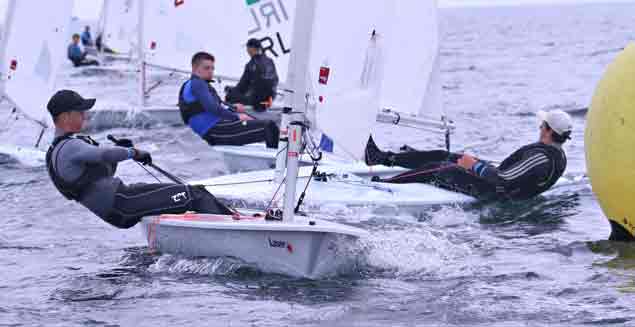 After two days Ewan MacMahon of Howth has the overall lead in the Laser Radials. Photo Mark Mackey
After two days Ewan MacMahon of Howth has the overall lead in the Laser Radials. Photo Mark Mackey
So anyway this Opty dad is telling anyone who is listening that the budget is already shot with the family spending a whole week in a house in a village he’d never heard of before. But now, worse still, somebody has just told him that his daughter is seen as one of the rising stars of the class, and they wouldn’t be surprised, once this weekend’s racing is finished, to see her name down as a potential member for the Irish squad at the Optimist Worlds 2017 at the Royal Varuna Yacht Club in Thailand in July.
“And do you know what that means?” he demands. “It means that if we accept that offer of a place at the Worlds, within a week we have to divvy up €2,000 for the International Optimist Dinghy Association of Ireland. I can tell you something” he continues, now in full flight, “if she’s anywhere within range of a place with only one or two races still to go, we’ll be seriously thinking of feeding her a dodgy chicken sandwich.....”
Such are the joys of being an Opty dad. And it was something to contemplate along with the fondest recollections at an event on Thursday night in my own home club of Howth, when friends from times past – some of them friends from very long times past – joined with the great and the good including ISA President Jack Roy and his wife Rosemary, and HYC Commodore Joe McPeake – together with a whole raft of former HYC Commodores – to celebrate the award by World Sailing (formerly ISAF) of a Gold Medal to Howth’s own Helen-Mary Wilkes for her decades of service to the International Optimist Dinghy Association worldwide.
 At the conferring of Honorary Membership of Howth Yacht Club on Helen-Mary Wilkes in celebration of her Gold Medal from World Sailing are (left to right) Jack Roy (President, Irish Sailing Association), Joe McPeake (Commodore Howth YC, who is holding a copy of Robert Wilkes’ History of the International Optimist Class,) Helen-Mary Wilkes, and Robert Wilkes. Photo: John Deane
At the conferring of Honorary Membership of Howth Yacht Club on Helen-Mary Wilkes in celebration of her Gold Medal from World Sailing are (left to right) Jack Roy (President, Irish Sailing Association), Joe McPeake (Commodore Howth YC, who is holding a copy of Robert Wilkes’ History of the International Optimist Class,) Helen-Mary Wilkes, and Robert Wilkes. Photo: John Deane
Her international career started when it was noted that she was the key player as Secretary of the Organising Committee when Howth ran the Optimist Worlds in 1981. After that, Helen-Mary’s international service was of such quality and duration that her most recent years with the IODA have been as President of Honour. For, in the many years she was actually running it all on a day-to-day basis with the backroom support of her husband Robert, they saw an increase of 78% in international membership of the world association to bring the total to 87 countries, and 57 of those countries regularly took part in international championships, while boat numbers increased stratospherically.
It was by no means an easy ride, for with main builders in several countries and different continents, the Optimists were by no means totally One-Design. But fortunately Helen-Mary Wilkes had the very man in Ireland with the skill, patience and diplomacy to sort this out - David Harte of Schull, at that time a Howth resident. As an Optimist builder himself, “Harty” knew everything about these very important little boats, and between 1995 and 1997 he was on an almost continuous worldwide mission to persuade the eight main builders to standardise the class to the highest One-Design requirements, an objective in which he succeeded.
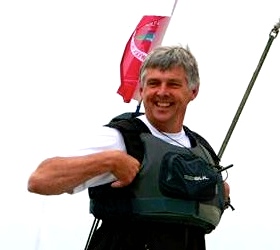 David Harte of Schull, who in 1995 -1997 was instrumental in ensuring that the eight production builders worldwide of the International Optimist Dinghy were producing a truly One-Design boat.
David Harte of Schull, who in 1995 -1997 was instrumental in ensuring that the eight production builders worldwide of the International Optimist Dinghy were producing a truly One-Design boat.
David Harte being one of these people who seems ageless, it takes a bit of an effort to realize that he was doing this all of twenty years ago. But the result has been a much more total global acceptance of the Optimist. And in speaking to Thursday night’s gathering, Helen-Mary and Robert Wilkes addressed people’s concerns that the current event in Ballyholme, and other major Optimist championships in Ireland, are becoming too serious for the good of the young sailors.
“We’re every bit as interested in the kids who are into Optimists just for club racing and local sailing as we are for the high flyers. Over Easter, there are five major Optimist regattas under way at different venues in Europe. In all, more then 4,500 Optimists are sailing at every possible level of competition in these events. Yet at none of those regattas is selection for special strands of training under way. Ultimately, it is all about sailing for sailing’s sake. It only happens to be the case that it’s in Ireland the Easter Regatta is also being used for the trials. Inevitably, there’s criticism that the kids are being put under too much pressure here. But as a matter of policy, the International Optimist Dinghy Association is as interested in friendly local racing as it is in international competition”.
 “Get ’em up and move ’em out....” Optimists and Lasers swing into the launch sequence at Ballyholme. Photo: Pierce Purcell Jnr
“Get ’em up and move ’em out....” Optimists and Lasers swing into the launch sequence at Ballyholme. Photo: Pierce Purcell Jnr
Meanwhile last night up at Ballyholme they were able to post two days of good racing results in westerly winds for the Laser Radials, 420s and Optimists, and one day of racing for the Toppers, Laser 4.7s and Topper 4.2s.
LASER RADIALS
After a 7th, 4th and 6th on Thursday, when Aaron Rogers of Rush SC was the overnight leader, Ewan MacMahon of Howth came back like a rocket yesterday and posted 1,1, and 2nd to leave him leadng on 14pts to the 20 of Henry Higgins of the Royal St George in second (4,(26) 2,4,2,8), with Johnny Durcan of Royal Cork finishing strongly with a bullet in yesterday’s concluding race for a scoreline of 2,8,10, (42 BFD) 3, 1 and a points total of 24. Rush SC pair of Conor Quinn and Aaron Rogers are next on 27 and 28 in a fleet of 43.
420
Geoff Power and James McCann of Dunmore East have recovered from an OCS yesterday to take over the lead in a healthy fleet of 16, they have totalled 6 points with a used scoreline of 2,1,1,1,1, with Gemma McDowell and Emma Gallagher of Malahide taking one of the two spare wins after the Power display of, well, power, the Malahide crew now lie second on 12 points, just one point ahead of the other race winners, Kate Lyttle and Niamh Henry of Royal St George.
OPTIMISTS
Justin Lucas (13) of Tralee and Royal Cork had been hotly tipped as the favourite for the Optimists, and he has certainly lived up to the billing with a scoreline of 1,1,(12),11,4,5,1 after two days of racing in a 62-strong fleet. There has been some post-racing re-arrangement of results with protest outcomes, but Lucas is well clear of Royal Cork’s Michael Carroll with 23 points to the 37 of Carroll in second, while James Dwyer Matthews (Cork & Kinsale) is tied on 40 with the leading junior Luke Turvey (Howth and National,) who goes to fourth on the higher discard. Leah Ricard of the National is top girl at 9th overall.
LASER 4.7
The National YC’s Clare Gorman leads after the first day of racing for the 4.7s, with a scoreline of 4,2, and 1 to give 7 pts against the 9 of Royal St George’s Jack Fahey in second, third slot being held by David Carroll of Kinsale & Crosshaven while Tom Higgins of RStGYC and Eva MacMahon of Howth tie on 16, but Higgins takes 4th on the discard in a fleet of 33.
TOPPER
Rob Keal of Royal Cork had a good first day of it yesterday to lodge two firsts and a fourth, giving him 6pts against the 11 of second placed Kate Fahy (RStGYC & Lough Derg) while East Down’s Sarah Jennings’ 13pts keeps her in third ahead of Royal Cork’s Conor Horgan on fourth in a fleet of 32.
TOPPER 4.2
Lewis Thompson of Ballyholme and Donaghadee has had three straight firsts to the three seconds of Ballyholme’s Hannah Dadley-Young, third overall is Donaghadee/Ballyholme’s Joshua McGregor with two hirds and a fourth while Adam Irvin of the Irish National Sailing School is fourth on 4,5,4.
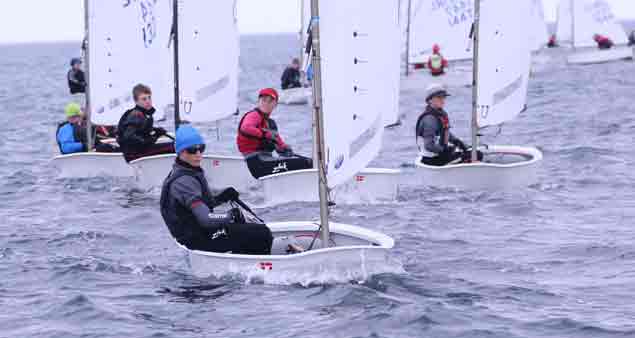 Justin Lucas of Tralee Bay is leading the 62-strong Optimist fleet. Photo: Mark Mackey
Justin Lucas of Tralee Bay is leading the 62-strong Optimist fleet. Photo: Mark Mackey
It is interesting to contemplate all this highly-regulated contemporary modern sailing on Belfast Lough, for it was far from Lasers and 420s and four days of intensive racing from committee boat starts that we were reared when we spent our first years afloat in and around Ballyholme Bay.
In those days, proper junior training and a structured junior racing programme weren’t so much in their infancy as barely a gleam in anyone’s eye. At a certain age – before any of us was even into our teens – we were given a new 14ft clinker sailing dinghy of the Ballyholme Insect Class, and told to get on with it on the assumption that, having sailed with adults in keelboats, we’d know how it was done.
 Steep learning curve. We weren’t even into our teens when we were presented with a 14ft Ballyholme Insect Class, and told to get on with it. Photo: W M Nixon
Steep learning curve. We weren’t even into our teens when we were presented with a 14ft Ballyholme Insect Class, and told to get on with it. Photo: W M Nixon
With a massive lack of imagination, we called her Grasshopper. In truth, Rockhopper would have been more on target. The distinctly exposed Ballyholme Bay is sheltered to the northeast, ’tis said, by Ailsa Craig, which is 40 miles away. Admittedly the bay has a decidedly featureless shoreline at low water, which limits sailing options even if you aren’t hampered by strong onshore winds. But when the tide is well in, all sorts of little islands and channels are created, and we learnt our sailing threading our way through this miniature maze of skerries.
 Ballyholme Bay at Low Water has a rather featureless shoreline....
Ballyholme Bay at Low Water has a rather featureless shoreline....
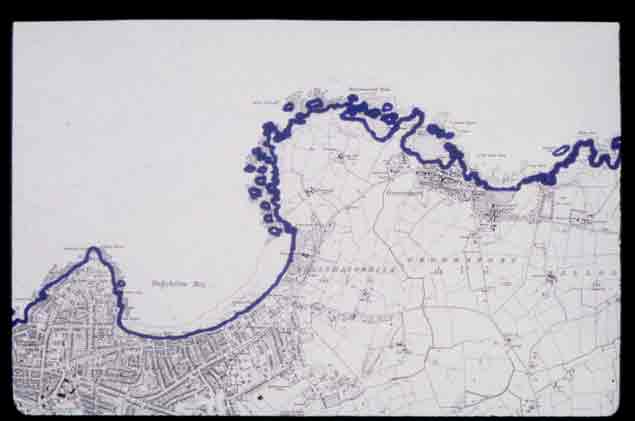 ....but at High Water it becomes a much more interesting place, with all sorts of islands and channels.........
....but at High Water it becomes a much more interesting place, with all sorts of islands and channels.........
 ......through which a sailing dinghy with centreplate half-raised can thread her way. Photo: W M Nixon
......through which a sailing dinghy with centreplate half-raised can thread her way. Photo: W M Nixon
There was of course no such thing as an accompanying rescue boat, but from time to time we sailed in consort with a friend whose boat was a smaller sister, a 12ft–clinker dinghy, but made more exotic with a little bowsprit.
Safety rules were few. We were expected to wear kapok lifejackets when actually sailing, but not otherwise, and they’d immediately be used as fenders if we came alongside rocks or small jetties. As for sailing limits, we were supposed to stay in Ballyholme Bay south of a line from Luke’s Point on the west side over to a rock called Jenny’s Isle off Ballymacormick Point to the northeast. However, at high water you could sail with the centreplate half up inside Jenny’s Isle and the tidal islets beyond it, so you could keep going east, while staying within that outer limit line, until you’d gone clean round the world.
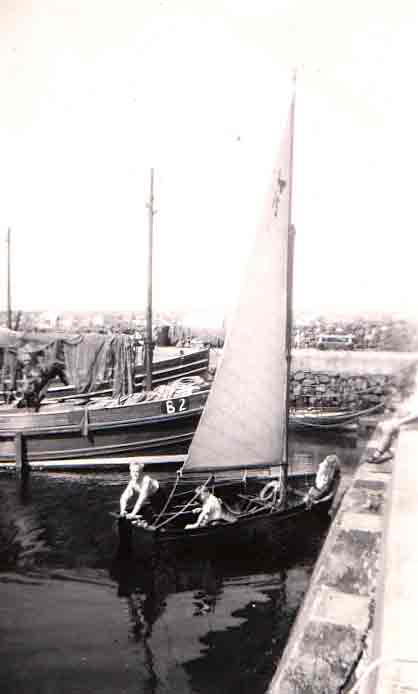 Groomsport, a little fishing harbour which was our first “foreign port.” It is less than two miles from the anchorage at Ballyholme Bay Photo: W M Nixon
Groomsport, a little fishing harbour which was our first “foreign port.” It is less than two miles from the anchorage at Ballyholme Bay Photo: W M Nixon
But there wasn’t that much mischief in us, so it was quite a day when official permission was given to sail all the way to the nearby fishing harbour of Groomsport, our very first Foreign Port of Call. And after that, the south shore of Belfast Lough from Orlock Point to Grey Point was our cruising paradise, and we’d disappear off for the entire day with a basic lunchbox and the hope of augmenting it with mackerel.
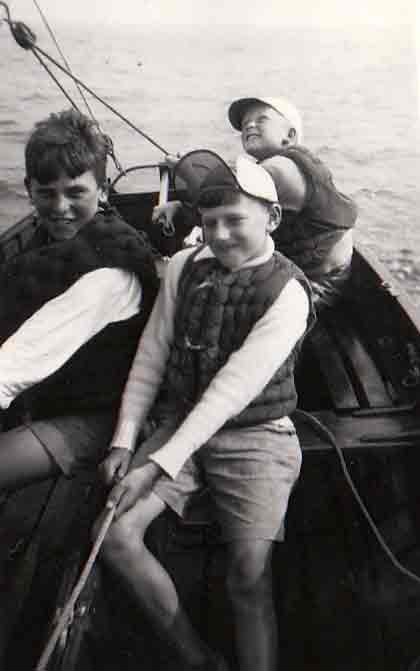 Off for a days cruising, with a lightly packed lunchbox and a couple of mackerel lines to augment the meal. Photo: W M Nixo
Off for a days cruising, with a lightly packed lunchbox and a couple of mackerel lines to augment the meal. Photo: W M Nixo
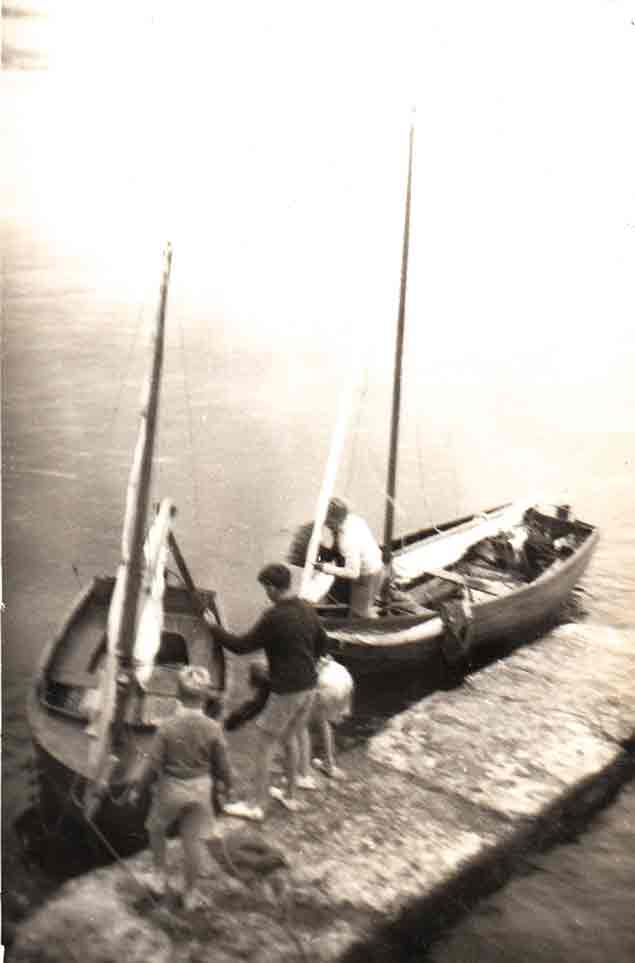 Cruise in company. The fleet gathers at Swinley Bay three miles west of Ballyholme, and lifejackets soon become fenders. Photo W M Nixon
Cruise in company. The fleet gathers at Swinley Bay three miles west of Ballyholme, and lifejackets soon become fenders. Photo W M Nixon
If the wind fell light in the evening, we could row home, and over the years nobody gave our daylong absences any thought. There were some close calls, but we never actually capsized the boat. Which was just as well, for if you capsized an Insect, she stayed capsized, and you were barred for a week from Ballyholme Yacht Club for what was deemed reckless and unseamanlike behavior.
That was how you learned to sail back in the day. Eventually it was reckoned we knew enough to be reasonably harmless to others if we went racing with what was then Ballyholme’s only dinghy class. A long way indeed from the hotshot dinghies of today, and their accompanying coaches in their RIBs.
#inss – Last week, Sailing on Saturday featured the Royal Cork Yacht Club, the oldest in the world, as it comfortably donned the mantle of the ISA/Mitsubishi Motors Sailing Club of the Year 2015. This morning, we find ourselves involved with what may well be the newest sailing club in the world, the Irish National Sailing Club. It is certainly, thanks to being inaugurated nearly three months after Youghal SC was founded on 28th October 2014, the newest in Ireland. W M Nixon tries to explain it all as he finds himself in the world of Irish sailing's most complete dynamo.
Alistair Rumball is a Life Member of the Awkward Squad. Cage-rattling and pot-stirring are second nature to him. But it's not because of experiencing an unhappy childhood. On the contrary, while growing up in Malahide, his boyhood summers were bliss. He and his brother Arthur had as much sailing as they could want, fitted in between part-time jobs raising pocket-money with a morning picking potatoes at Dermot Dickie's farm along the Broadmeadow Estuary, followed by an afternoon of sailing the sea with the sun always shining, and then maybe an evening of club racing followed by the easy camaraderie among kids who are comfortable with boats.
It was an idyllic maritime environment which, over the years, has produced some of Ireland's top racing and cruising sailors. But while the young Rumball was no slouch on the race-course, the strongest feeling he had about sailing was the sheer fun of it all, the totally absorbing wonder of being in a boat and hauling on ropes to make sails change shape and help you along your chosen course over the always interesting sea.
Although he graduated from Trinity College Dublin as an engineer, he increasingly had this almost evangelical attitude to spreading the good news about the fun of sailing. And while he has something of a reputation – to say the least - for being confrontational, it's central to his contradictory character that he's an extremely good teacher. If somebody shows the slightest genuine enthusiasm about wanting to learn to sail, Alistair Rumball has been prepared to go to endless lengths to teach him or her to do so, and to do so with enjoyment.
Underlying that, we find the first of his gripes about the modern sailing scene. He reckons that it has become far too serious. Don't think for a moment, though, that he believes in a frivolous approach to boats and sailing. He's deadly serious about having everything just right as regards safety and function.
But once that's sorted, then he firmly believes that you should go out and enjoy it. He waxes lyrical about moments of sheer sailing ecstasy he has enjoyed in a wide variety of boats in many sailing locations worldwide. And whatever he may have formally set out to be in a professional career, his working life has been spent in and around boats, getting people introduced to boats and out afloat, sometimes on an almost industrial scale.
Time was when sailing skills were something you acquired by a sort of osmosis through family tradition, club opportunities, and friendship examples. That's mostly how Rumball himself learned to handle a sailing boat. But he seems to have this almost messianic zeal to teach people to sail, and he became convinced that the future lay in more structured training with a proper syllabus.
Having taken a long hard look at the population distribution of the Greater Dublin area and where they might best get afloat in worthwhile numbers, in 1978 he acquired the assets of a moribund organisation, the Dun Laoghaire Sailing School, and soon found himself giving his first lessons to two pupils using a fibreglass-clinker Darragh 14 knockabout sailing dinghy which they'd launched from the public slipway in the Coal Harbour in Dun Laoghaire. The long journey had started towards an organisation whose activities today today include top-of-the-line race training in 1720s in winning mode:
The majestic granite harbour of Dun Laoghaire was a cold place in 1978 for any young enthusiasts trying to set up an independent sailing school on a commercial basis. For the powers that be, sailing was something to be learned through family and clubs under the Junior Training Programme of the Irish Yachting Association. If you were a young person or adult from a non-sailing background but keen to learn, unless you'd an obliging and patient friend from within the sailing establishment, the expectation was that you'd take yourself off to somewhere far away like the Glenans Ireland bases in Baltimore and Bere Island and Clew Bay, and eventually reappear after a decent interval with enough experience, newfound ability and contacts to make the grade in the Dublin Bay sailing scene, where the very thought of a raw in-harbour sailing school for outsiders seemed distasteful to the establishment.
Yet hidden away in the southwest corner of Dun Laoghaire harbour, here was this gadfly of the sailing scene, Can–do Alistair with his rough and ready sailing school enthusiastically recruiting pupils anywhere and everywhere, and taking them afloat in boats which may not have been in the most pristine condition, and certainly set sails which would not be winners on the race course, yet they were safe and able, and so were he and his instructors.
Over the years, an entire cohort of people, mainly from Dublin but also from all over Ireland with a useful smattering of pupils from abroad, came to boats and sailing thanks to this wild-haired character whose love of his demanding work shone through everything he did.
Gradually the fleet expanded, and so too did the "Rumball Group's" activities, even though the very limited availability of premises on the Dun Laoghaire waterfront meant that every little square foot they had always seemed to serve at least three different purposes. But they were getting there, they opened a retail outlet in the town to sell boat gear and equipment which became Viking Marine, the school promoted itself to being the Irish National Sailing School, and they were well settled in place, using every inch of space on the ground floor of the interesting little building on the southwest corner of the harbour which used to be the Nautical College.

The man and his machines – Alistair Rumball and his chariot outside the Irish National Sailing School's HQ in Dun Laoghaire. Photo: W M Nixon
Centuries ago, seafaring education was given a significant role in Irish life in the late 1700s, the 1800s, and the early 1900s with the old Marine School a fine building on the south quays in Dublin. But its premises were re-allocated for development purposes and the school itself had its final home in Clontarf before being absorbed only as a vague memory into what is now Mount Temple Comprehensive school.
These days, the marine education focus has moved to Cork with the fabulous new National Maritime College in Ringaskiddy, but for that low period in Irish maritime life in the mid 20th century, one of the few keepers of the flame was Captain Tom Walsh who operated the little Nautical College in this fairly inconspicuous Office of Public Works building now hidden away behind the Dun Laoghaire Motor Yacht Club.

Captain Tom Walsh in teaching mode in 1957 in the INSS building when it was the Nautical College.

The 110ft barquentine which Jack Tyrrell designed for Captain Tom Walsh's Nautical College in 1954 in the hope that it would inspire the building of an Irish Tall Ship
It was the gallant Captain Walsh who in 1954 commissioned Jack Tyrrell of Arklow to design a 110ft sailing ship – a barquentine – to be Ireland's very own tall ship, our first sailing training vessel. God bless the good captain, but he was convinced that if he could just get someone in Government to see these inspiring plans, then such a ship would be on the way.
You can imagine just how far such a visionary idea travelled in the deadly dull Ireland of the 1950s. Far from getting a proper training ship built, Captain Walsh had enough trouble keeping his college in being. Yet he was a gentleman and enthusiast to the end, and after retirement he augmented his pension by testing compasses in yachts, which I remember well as he did it for me with a little cruiser in 1981. The only mutually convenient time it could be done was on a Saturday evening, and I'd to get the boat from Howth to Dun Laoghaire to do it, but the actual swinging of the compass by Tom Walsh was such a pleasant and educational experience that any thoughts of being at some Saturday night party were entirely banished.
So when you go into the main premises of the Irish National Sailing School today, it's natural to remember Captain Tom Walsh, and I like to think that he would thoroughly approve of the old building's current usage, for Alistair Rumball and his team are mighty busy during what must sometimes be an 18-hour day, and just this week – before the sailing season is really fully under way – Monday was typical, with 185 schoolkids bussed down from Maynooth for a day's coaching afloat, followed by all sorts of gatherings including a committee meeting of the newly-formed Irish National Sailing Club.
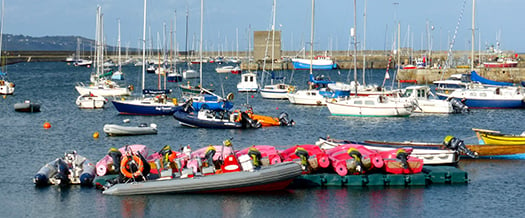
Space is so constrained that a floating dinghy park has to be used to store the smaller craft. Photo: W M Nixon
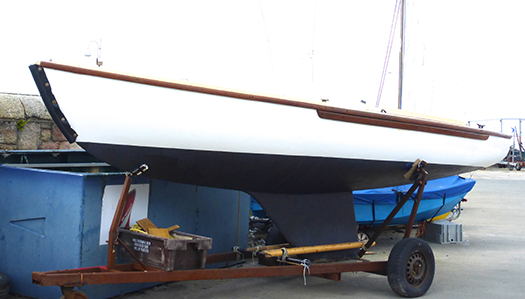
Thanks to the special INSS fendering devised by Arthur Rumball, this 35-year-old Squib has survived many seasons of tough teaching in good order. Photo: W M Nixon
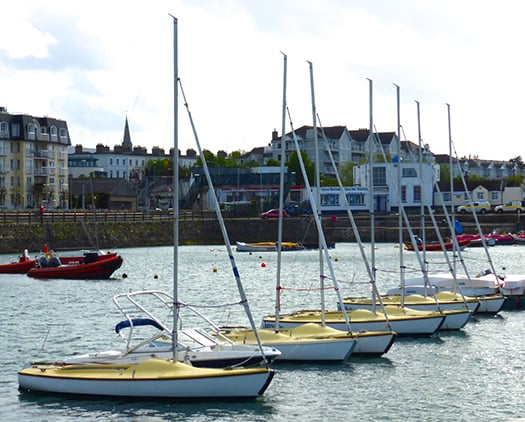
To economise on space, the Squibs berthed here, with the INSS building in the background, are double-moored. Photo: W M Nixon
Of which more anon, for this bare outline gives only a hint of the INSS's complex programme. The Rumball theme is that you have to keep operations and facilities flexible to cope with fluctuating demand, for at the height of the season the school is operating a fleet of 200 boats ranging from kayaks through sailing dinghies of increasing size, then on into keelboats of which some well-fendered Squibs are the workhorses while 1720s provide the glamour input, and finally at the top of the tree there's the Reflex 38 Lynx, bought from Galway this past winter, and becoming part of a programme headed by Alistair's son Kenneth – a Silver Youth Medallist in the 420 – who is now a fully-qualified offshore racing pro teacher, but also races the 1720s while being main operations director of a school which has five full–time employees, but in all has sixty staff at the height of the season.
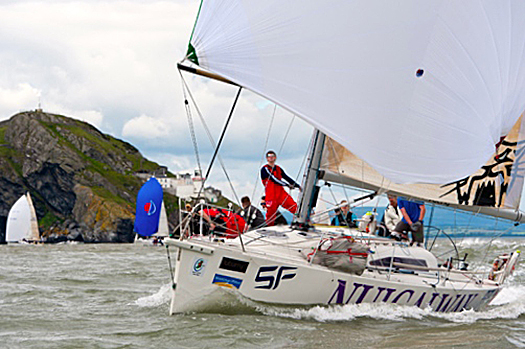
The latest addition to the INSS fleet is the Reflex 38 Lynx, seen here racing for NUI Galway during the Round Ireland. In 2015, Lynx has already scored a second overall in ISORA racing skippered by Kenneth Rumball.
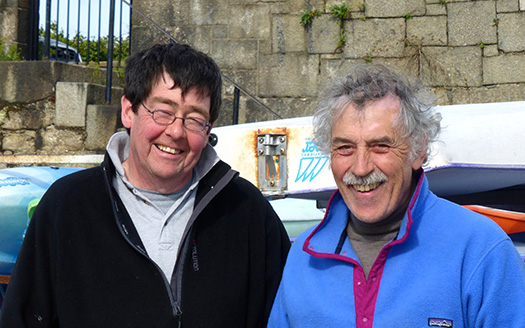
Brothers in business – seen here with his brother Alistair, Arthur Rumball (left) runs the often very busy INSS boat maintenance facility. Photo: W M Nixon
As to shoreside facilities, each summer they set up an additional seasonal summer base to the west of the West Pier with top-of the-line Portakabins at Salthill to provide facilities for those sailing dinghies and kayaks, and in addition the INSS have their own boat-maintenance unit under Arthur Rumball beside the boatyard in the Coal Harbour.
So an impressive amount of things have happened since 1978, the best of them surely being that Alistair persuaded Muriel, a country girl from one of the most beautiful parts of County Carlow, to marry him. For Muriel is a teacher by profession, and adept at being the peace-maker who smooths the waters after Alistair has been making waves, which even now still seems to be just about all the time.
That said, he gives the impression of having so many chips on his shoulder about the perceived opposition to his ventures by those in authority that you begin to think it might be just a bit of an act, for underneath it all he has a heart of gold, yet with the spirit of a lion who will fight the good fight to defend his territory and the interests of his family, friends, trainees and businesses.
The quality of the man was well revealed when the economic recession struck. At the height of the boom years, the Irish National Sailing School had a throughput of more than 2,500 people per month coming new to sailing, and it had become a vibrant and trendy part of the recreational fabric of good-time Dublin. Then around 2008, the economy went into free-fall. But the INSS survived both by making severe cutbacks in everything, and utilising another string in Alistair's bow.
Because of his ready enthusiasm to undertake just about everything and anything to do with boats, back in 1982 he'd looked after some waterborne scenes with classic small craft for the Channel 4 TV comedy-drama series The Irish RM, starring Peter Bowles and Bryan Murray, which went out between 1983 and 1985. It was grand at the time, but thirty years down the line it now seems to have a dose and more of the Paddywhackery about it. However, that was neither here nor there for Alistair Rumball in 1982, for it gave him a lucrative little sideline, and over the years since he has been the man to go to if you want to set up boats and sailing ship scenes in the Irish movie-making business.
So it's ironic, when we remember that Malahide was where the rather mouldy old Vikings of Dublin made their last base after their city had been captured by the Normans in 1171, that it should be a Malahide boy who has emerged as the behind-the-scenes captain of ships for the filming of the blockbuster series Vikings.

When you've spent most of your working life teaching people to sail, tutoring Thespian Viking crewmen on a Wicklow lake is just an ordinary part of another day at the office.
It has all been happening for some years now up in the Wicklow mountains and out on the Wicklow lakes, which have passed themselves off very well as Norwegian fjords, yet can double quite effectively as the coastal and riverside scenery of the many places where the Norwegian Vikings wreaked mayhem.
Who knows, but maybe with the passage of time the epic Vikings series will come to be seen as the epitome of Scandiwhackery, but for now, it certainly does the business . For as the Irish economy fell off a cliff, Alistair Rumball soared aloft in creating, managing, and manoeuvring a very authentic and substantial Viking longship flotilla which has provided a proper Tinseltown income to make all things possible, while helping underwrite the future of the Irish National Sailing School.
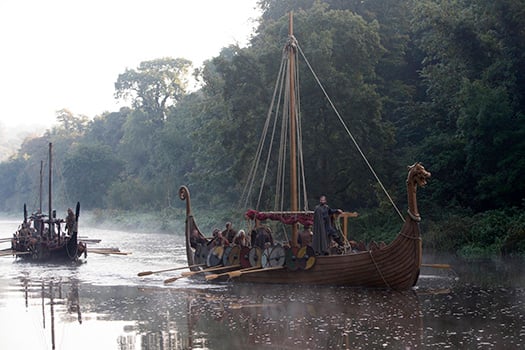
Lough Dan in County Wicklow - where Erskine Childers first sailed around 1890 – has proved remarkably versatile in providing backgrounds for the Vikings which could either be Norway itself, or else the shores of places they are raiding
But it's extraordinarily demanding and time-consuming work, even if he has a staff of 150 specialists up in the Wicklow hills, and after a year or two it became clear that he was trying to do too much. So four years ago his son Kenneth, who is now 27 and was at the time working as an accountant, moved in to take over the direction of the sailing school, and as the recession has started to recede – last year they had monthly numbers pushing back towards the 2,000 mark - Kenneth's energetic and all-encompassing input is seeing the school increasing the scale of its operations, particularly in what might be called the post-graduate side with the development of 1720s at top race level. Now the acquisition of Lynx has developed things further - she has already made what was a rather hasty debut in the first ISORA of the year, but despite being only minutes out of the box, they placed second overall, and that only by six minutes.
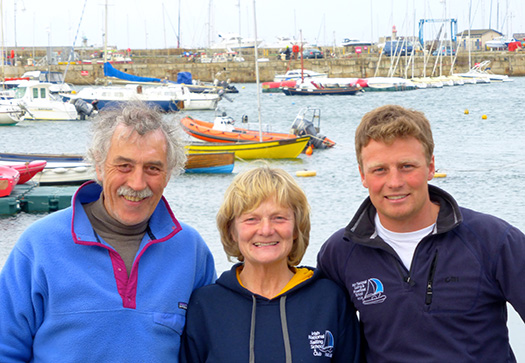
Alistair, Muriel and Kenneth Rumball. Photo: W M Nixon
This placing of racing as a natural part of the INSS syllabus has in turn led to the need for an officially-constituted club to comply with race entry requirements. But in reality the INSS has had a genuine club atmosphere for years, indeed it has more of a truly club-like atmosphere than many a historically-constituted old yacht club. So it was only a formality to bring the Irish National Sailing Club into being in January 201, but it's for real, here's a pic of the Committee of the new club meeting in the old Tom Walsh building on Monday, and if you want to join, it will cost you the outrageous sum of €10.
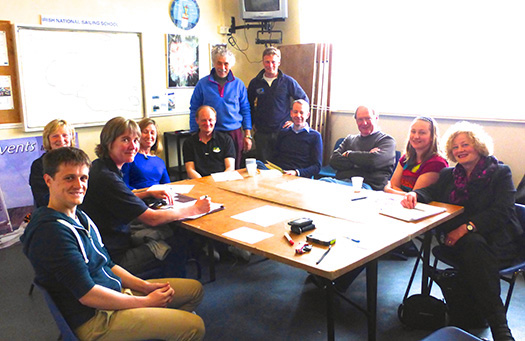
The committee and school management of the newly-formed Irish National Sailing Club are (left to right) Glyn Williams (foreground), Muriel Rumball, Joan Sheffield, Caroline Herron, Robin Jones, Alistair Rumball, Kenneth Rumball, Garrett O'Malley, Dermot Igoe, Heather Blay and Mary Beck. Photo: W M Nixon
As to how Alistair Rumball views the impending possible re-structuring of Dun Laoghaire as a cruise liner port, with inevitable limitations on the amount of sailing which can take place within the harbour, he is both an idealist and a realist.
Like many of us, he dearly wishes that this splendid granite creation could be seen as a cherished part of our heritage, not as something to be used to generate income to turn a crude profit or even just to pay its own maintenance costs. Rather, we'd ideally like to see it treated as a national asset to provide vital recreational space for everyone afloat and ashore.
But Alistair Rumball senses that the government's determination to use just about everything in public ownership to generate income will win the day, and he is already being realistic about what the regular if summer-emphasised arrival of cruise liners will mean.
In fact, he may even derive a certain sardonic satisfaction from seeing the Dun Laoghaire sailing establishment having to contemplate accepting conditions with which his school has complied ever since he began operating it.
"People should realise" he asserts, "that there are already two clearly-define shipping channels in Dun Laoghaire Harbour. One is from the harbour entrance to St Michael's Wharf, which will simply be retained if the cruise liners come. The other, much less widely known, is supposed to be from the harbour entrance to the berth at the Band Stand on the East Pier. Even at present, you are not meant to operate under sail in either of those channels, but an awful lot of boats do so."
"However, as we are a commercial operation, we have a strict policy of complying with regulations and carrying out our sail training and teaching operations in the western part of the harbour, clear of the main channel. So a cruise liner should not affect our in-harbour activities, while our larger craft going out into the bay will have to comply with shipping regulations in the entrance like everyone else".
Whatever happens, we may be sure that the Irish National Sailing School and the Irish National Sailing Club - and their splendid founder - will continue to be a thorn in the side of those who take themselves too seriously and have an inflated idea of their own importance. But if you've never been in a boat before and know nobody in sailing, yet feel a growing enthusiasm to go sailing in Dun Laoghaire, you now know where to go to experience the real thing.
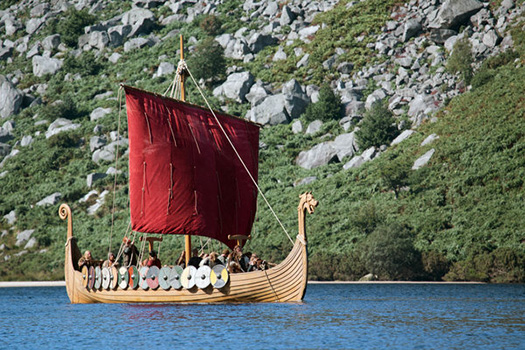
The other side of the INSS show – a Viking ship looking good on Lough Dan
INSC Relaunches Adult Teaching & Club Programme
Irish National Sailing School and Club is relaunching its adult teaching and club programme.
Sailing courses will now be offered on weekends for Levels 1 and 2 and selected weekday evenings for those completing L2. Both levels are offered in sports yachts and dinghies.
In addition, there will be three adult club sessions each week, as well as a number of upcoming special events.
For more details visit the Irish National Sailing Club website at www.insc.ie.



























